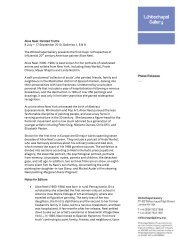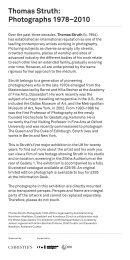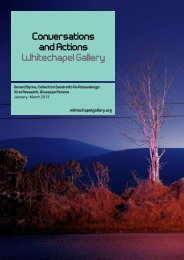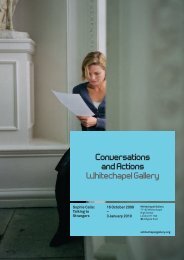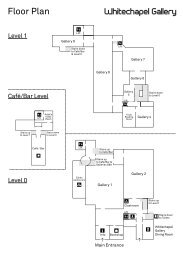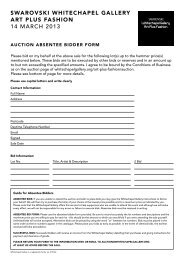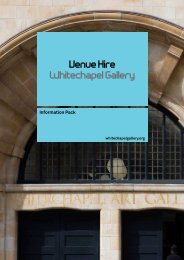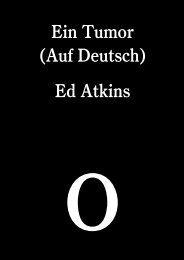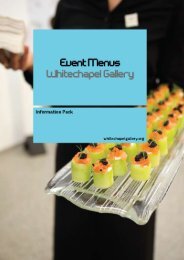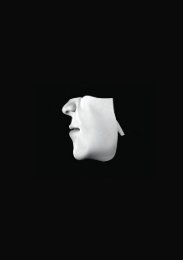Sophie Calle: Talking to Strangers - Whitechapel Gallery
Sophie Calle: Talking to Strangers - Whitechapel Gallery
Sophie Calle: Talking to Strangers - Whitechapel Gallery
You also want an ePaper? Increase the reach of your titles
YUMPU automatically turns print PDFs into web optimized ePapers that Google loves.
<strong>Sophie</strong> <strong>Calle</strong>: <strong>Talking</strong> <strong>to</strong> <strong>Strangers</strong><br />
16 Oc<strong>to</strong>ber 2009 – 03 January 2010<br />
Galleries 1, 8, 9<br />
The <strong>Whitechapel</strong> <strong>Gallery</strong> presents the first UK retrospective of leading French<br />
contemporary artist <strong>Sophie</strong> <strong>Calle</strong>.<br />
<strong>Sophie</strong> <strong>Calle</strong>’s works are most frequently described in terms of shadowing<br />
and voyeurism, involving constructing identities and creating complex<br />
scenarios that are then documented through pho<strong>to</strong>graphs and texts. They<br />
explore the field of social relations, each proposing an exchange, transaction<br />
or social contract with those whose lives she momentarily crosses. This<br />
exhibition brings <strong>to</strong>gether 12 key works from the late 1970s <strong>to</strong> the present,<br />
including the acclaimed installation Prenez Soin De Vous (Take Care of<br />
Yourself), 2007.<br />
<strong>Calle</strong> began taking pho<strong>to</strong>graphs of strangers on the streets of Paris in 1979.<br />
Her works arise from a series of actions or encounters; their parameters are<br />
dictated by the use of rules and instructions that echoes conceptual practices<br />
of the 1960s and 70s. Her position as subject within her work <strong>to</strong> explore social<br />
constructs has also drawn parallels with performance art of the same period.<br />
<strong>Calle</strong>’s works are presented in a pared down, objectivist manner that alludes<br />
<strong>to</strong> the disciplines of journalism, anthropology or psychoanalysis. Her works<br />
also make use of literary devices, as well as everyday forms such as the diary<br />
and the pho<strong>to</strong> novel. The boundaries between fact and fiction are often<br />
ambiguous.<br />
The exhibition will premiere the English language version of Prenez Soin De<br />
Vous (Take Care of Yourself), which the artist first exhibited at the French<br />
Pavilion at the Venice Biennale in 2007. This large-scale, multi-media<br />
installation, which will occupy the entire ground floor <strong>Gallery</strong> 1, takes as it’s<br />
starting point an email in which her partner informs the artist that he is<br />
leaving her. <strong>Calle</strong> invited over 100 women from different professional<br />
backgrounds – lawyers, ac<strong>to</strong>rs, accountants, singers – <strong>to</strong> comment through<br />
the lens of their professional vocabulary. The poignant, amusing and often<br />
poetic result transcends the personal <strong>to</strong> provide a polyphonic portrait of, and<br />
monument <strong>to</strong>, the women involved.<br />
The exhibition continues in the upstairs galleries with an overview of earlier<br />
work. It includes The Sleepers, 1979, in which the artist invited 29 strangers<br />
<strong>to</strong> sleep in her bed. For The Bronx, 1980, <strong>Calle</strong> asked random inhabitants of<br />
the south Bronx <strong>to</strong> show her a place of their choice in what was then one of<br />
city’s most violent neighbourhoods, a place that they would always remember<br />
should they one day leave. The collaborative nature of <strong>Calle</strong>’s work finds<br />
different expression in works where her own actions and activities are<br />
dictated by others. They include the American novelist Paul Auster in Gotham<br />
Handbook, 1994 and Maud Kirsten, a medium and clairvoyant, in Berck, 2008.<br />
Other works in the exhibition include: The Address Book, 1983; Ana<strong>to</strong>li, 1984;<br />
Los Angeles, 1984; The Detachment, 1996; Journey <strong>to</strong> California, 2003;<br />
Unfinished, 2003; Pas Pu Saisir La Mort (Couldn’t Capture Death), 2007.
Notes for Edi<strong>to</strong>rs<br />
• <strong>Sophie</strong> <strong>Calle</strong> was born in Paris in 1953 and has had solo shows at Palais<br />
des Beaux-Arts, Brussels, 2009; Bibliothèque Nationale Richelieu, Paris,<br />
2008; Martin-Gropius-Bau, Berlin 2004; Centre Pompidou, Paris, 2003;<br />
Toyota Municipal Museum of Art, Japan, 2003. Group shows include<br />
Portraits-Souvenirs, Grand Palais, Paris, 2007; Passion Complex, 21 st<br />
Century Museum of Contemporary Art, Kanazawa, Japan, 2007;<br />
Pho<strong>to</strong>graphs, Metropolitan Museum of Art, New York, 2001, Sydney<br />
Biennial, 2000, Museum as Muse, MoMA, New York, 1999 and Carnegie<br />
International 1991. In 2007 <strong>Calle</strong> represented France at the Venice<br />
Biennale.<br />
• The exhibition is curated by Andrea Tarsia, Head of Displays & Cura<strong>to</strong>rial<br />
Studies, <strong>Whitechapel</strong> <strong>Gallery</strong>, and organised in collaboration with the De<br />
Pont Museum of Contemporary Art in Tilburg where it will be on show 16<br />
January – 16 May 2010.<br />
• The exhibition will be accompanied by The <strong>Sophie</strong> <strong>Calle</strong> Reader that brings<br />
<strong>to</strong>gether key writings about her practice, co-published by Violette<br />
Editions and the <strong>Whitechapel</strong> <strong>Gallery</strong>, £12.95<br />
• A limited edition print, specially created by <strong>Sophie</strong> <strong>Calle</strong>, will be available<br />
from the <strong>Gallery</strong>.<br />
• Exhibition supported by CULTURESFRANCE - Ministère des Affaires<br />
étrangères et eruopéennes<br />
Visi<strong>to</strong>r Information<br />
<strong>Sophie</strong> <strong>Calle</strong>, 16 Oc<strong>to</strong>ber 2009 – 03 January 2010, <strong>Whitechapel</strong> <strong>Gallery</strong>.<br />
Admission free. Opening times: Tuesday – Sunday, 11am – 6pm, Thursdays,<br />
11am – 9pm. <strong>Whitechapel</strong> <strong>Gallery</strong>, 77 – 82 <strong>Whitechapel</strong> High Street, London<br />
E1 7QX. Nearest London Underground Station: Aldgate East, Liverpool Street,<br />
Tower Gateway DLR. T + 44 (0) 20 7522 7888 info@whitechapelgallery.org<br />
whitechapelgallery.org<br />
Press Information<br />
The media view for <strong>Sophie</strong> <strong>Calle</strong> is Tuesday 13 Oc<strong>to</strong>ber, 10am – 1pm.<br />
For further press information please contact:<br />
Rachel Mapplebeck on 020 7522 7880, 07811 456 806 or email<br />
RachelMapplebeck@whitechapelgallery.org<br />
Elizabeth Flanagan on 020 7522 7871 or email<br />
ElizabethFlangan@whitechapelgallery.org
British Council Collection: My Yard<br />
2 Oc<strong>to</strong>ber–6 December 2009<br />
<strong>Gallery</strong> 7<br />
Artists Jeremy Deller and Alan Kane curate the third selection of works<br />
from the British Council Collection. Their well-known preoccupation with<br />
popular culture trickles through their choices, which focus largely on a<br />
view of gritty urban Britain.<br />
My Yard examines Britain’s industrial his<strong>to</strong>ry and urban realities as seen<br />
by artists throughout the 20th century. Works include Edward<br />
Wadsworth’s dynamic landscapes which reflect the upheaval of industry<br />
and World War I, and L.S. Lowry’s painting of his native Manchester,<br />
Industrial City, 1948. The Boyle Family find unexpected beauty in the built<br />
environment, while John Davies explores urban archaeologies in his<br />
pho<strong>to</strong>graphic studies of Sheffield and S<strong>to</strong>ckport. The folly of u<strong>to</strong>pian<br />
<strong>to</strong>wn planning is parodied in Paul Noble’s fantastical city drawings.<br />
Jeremy Deller and Alan Kane said, ‘This exhibition has ended up being<br />
about home. The subject may not be immediately recognizable though,<br />
(especially <strong>to</strong> anyone born after 1970) as in the 1980s the UK got a sort of<br />
TV makeover – a lick of paint and some up-lighters etc. but the works we<br />
are showing indicate a Britain just below the plasterboard of this ‘flip’<br />
job, a draughty and slightly damp property with foundations that you feel<br />
connect it, back through mud and bones, <strong>to</strong> all you think of when you talk<br />
of British his<strong>to</strong>ry.’<br />
This display marks the British Council’s 75 th anniversary. It is the third in<br />
a series of five displays presented over one year and selected by guest<br />
cura<strong>to</strong>rs, supported by specialist insurer Hiscox. The fourth exhibition<br />
will be curated by artist Paula Rego. The final display in Spring 2010 will<br />
result from an international competition open <strong>to</strong> cura<strong>to</strong>rs worldwide.<br />
Notes for Edi<strong>to</strong>rs<br />
• London based artists Jeremy Deller and Alan Kane have worked<br />
<strong>to</strong>gether on a variety of projects over the last 15 years. Their<br />
collaborative works, as with their distinguished individual<br />
practices, often involve participa<strong>to</strong>ry processes and interrogate<br />
notions of high and low culture.<br />
• They are best known for the Folk Archive (1999-2005), a vast<br />
compendium of contemporary artefacts and eclectic ephemera<br />
collected from across Britain and Ireland. Previous projects<br />
include working with amateur steam enthusiasts <strong>to</strong> create<br />
mo<strong>to</strong>rised ‘internet machines’ (2003, 2006), and exhibiting the<br />
Women’s Institute prize winning floral decorations in the entrance<br />
hall of Tate Britain (2000),
• Deller (b. London, 1965) won the Turner Prize in 2004. He rose <strong>to</strong> prominence in 2001 for his<br />
recreation of The Battle of Orgreave. He has exhibited widely both nationally and<br />
internationally, most recently in solo presentations at Manchester’s Cornerhouse and the<br />
New Museum of Contemporary Art, New York (both 2009).<br />
• Kane (b. Nottingham, 1961) has exhibited nationally and internationally and has recently<br />
completed a series of high profile commissions. These include The Stratford Hoard (Art on<br />
the Underground, 2008) and Life Class: Today’s Nude, an Artangel/Jerwood commission<br />
which was televised nationally on Channel 4 in July 2009.<br />
• The British Council was founded in 1934 <strong>to</strong> promote a wider knowledge of the UK abroad, <strong>to</strong><br />
promote the knowledge of the English language, and <strong>to</strong> develop closer cultural relations<br />
between the United Kingdom and other countries. The arts play a major role in international<br />
cultural relations, and for 75 years the Council has curated, organised and facilitated<br />
pioneering exhibitions of British art throughout the world. The full British Council Collection is<br />
now available <strong>to</strong> view online on our new collections website<br />
www.britishcouncil.org/collection<br />
• The British Council Collection displays at the <strong>Whitechapel</strong> <strong>Gallery</strong> are organised by Diana<br />
Eccles, Head of Collection, The British Council Collection, and Andrea Tarsia, Head of<br />
Displays, <strong>Whitechapel</strong> <strong>Gallery</strong>.<br />
• The British Council Collection spans the 20th Century and includes works by early modern<br />
masters such Stanley Spencer, Wyndham Lewis, Paul Nash and Walter Sickert, Barbara<br />
Hepworth, Graham Sutherland, Henry Moore and Ben Nicholson. Post-war it includes, among<br />
others, artists from the School of London; painters from St Ives and from the Kitchen Sink<br />
group; exponents of the New Generation in the 1960s; conceptual and experimental artists<br />
such as Gilbert & George and Richard Long; the New British Sculp<strong>to</strong>rs of the 1980s, including<br />
Tony Cragg, Richard Deacon, An<strong>to</strong>ny Gormley and Anish Kapoor. Tracey Emin, Gary Hume,<br />
Damien Hirst, Mark Wallinger and Sarah Lucas are among the YBA generation represented<br />
and artists including Jeremy Deller, Douglas Gordon, Tomma Abts and Roger Hiorns bring the<br />
Collection up <strong>to</strong> the present day.<br />
• The presentation of the British Council Collection at the <strong>Whitechapel</strong> <strong>Gallery</strong> is supported by<br />
specialist insurer Hiscox which has a long and established association with contemporary art<br />
and was one of the first UK insurers <strong>to</strong> offer art insurance as a stand-alone policy for private<br />
collec<strong>to</strong>rs, museums and galleries. Hiscox’s sponsorship of the <strong>Whitechapel</strong> <strong>Gallery</strong>’s<br />
presentation of great collections underlines its commitment <strong>to</strong> promoting and protecting the<br />
very best in modern and contemporary art.<br />
Visi<strong>to</strong>r Information<br />
British Council Collection: My Yard, 2 Oc<strong>to</strong>ber – 6 December 2009, <strong>Whitechapel</strong> <strong>Gallery</strong>.<br />
Admission free. Opening times: Tuesday – Sunday, 11am – 6pm, Thursdays, 11am – 9pm.<br />
<strong>Whitechapel</strong> <strong>Gallery</strong>, 77 – 82 <strong>Whitechapel</strong> High Street, London E1 7QX. Nearest London Underground<br />
Station: Aldgate East, Liverpool Street, Tower Gateway DLR. T + 44 (0) 20 7522 7888<br />
info@whitechapelgallery.org whitechapelgallery.org<br />
Press Information<br />
The media view for British Council Collection: My Yard is Tuesday 13 Oc<strong>to</strong>ber, 10am – 12pm.<br />
For further press information please contact:<br />
Rachel Mapplebeck on 020 7522 7880, 07811 456 806 or email<br />
RachelMapplebeck@whitechapelgallery.org<br />
Elizabeth Flanagan on 020 7522 7871 or email ElizabethFlangan@whitechapelgallery.org
<strong>Whitechapel</strong> <strong>Gallery</strong> Exhibitions: Autumn 2009<br />
The British Pavilion at the Venice Biennale<br />
26 September–13 December 2009<br />
The <strong>Whitechapel</strong> <strong>Gallery</strong>’s exhibition space dedicated <strong>to</strong> archive displays<br />
presents a selection of material from the British Council’s archives <strong>to</strong> bring<br />
<strong>to</strong> life the his<strong>to</strong>ry of the British Pavilion at the Venice Biennale from 1938 <strong>to</strong><br />
<strong>to</strong>day. The Venice Biennale provides a barometer for contemporary art<br />
worldwide. Its his<strong>to</strong>ry of nationalism, protest and war is closely intertwined<br />
with the wider political and ideological struggles of twentieth century<br />
Europe right back <strong>to</strong> the exhibition’s foundation in 1895 as the world’s first<br />
regular international exhibition of contemporary art. Admission Free.<br />
Inci Eviner<br />
16 Oc<strong>to</strong>ber 2009–3 January 2010<br />
Inci Eviner’s film, Harem, 2009 is based on a series of early 19th century<br />
engravings by German artist An<strong>to</strong>ine Ignace Melling, who was invited by<br />
Sultan Selim the Third <strong>to</strong> chronicle the court and city of Constantinople.<br />
Eviner replaces the original figures with animations of women performing<br />
repetitive, mundane actions. Shown on a continuous loop the film challenges<br />
the Western perception of the harem as a place of sexual intrigue and<br />
subjugation with an alternative view of it as a place where women are the<br />
active. Admission Free<br />
Faisal Abdu’Allah: White (Why Have I Told Everything)<br />
30 September–1 November 2009<br />
Collaboration runs as a seam of critical enquiry through the work of Faisal<br />
Abdu’Allah. For White (Why Have I Told Everything), Abdu’Allah reflects on<br />
this project, and examines the hidden s<strong>to</strong>ries found in archival surveillance<br />
films and reports. Using as his starting point, the Cable Street Riot of 1936,<br />
which saw the metropolitan police facilitating a Fascist march through the<br />
predominantly Jewish area of east London, the artist brings <strong>to</strong>gether an<br />
installation including archive footage, documentation and pho<strong>to</strong>etchings of<br />
this important political event. Admission free. Supported by: Tower Hamlets, Find<br />
Your Talent<br />
In<strong>to</strong>art: See the Revolutionary Art Exhibit<br />
7 November–6 December 2009<br />
South London art collective In<strong>to</strong>art was founded in 2001 by Guy Allott, Sam<br />
Jones and Ella Ritchie. Here the group present their distinctive approach <strong>to</strong><br />
studio practice, that includes people who have a learning disability. The<br />
exhibition includes new work by Ntiense Eno Amooquaye, Selina Helene,<br />
Mawuena Kattah, Doreen McPherson, Philomena Powell and Clif<strong>to</strong>n Wright<br />
alongside 4 short films which document the lives and working processes of<br />
the artists by Lenka Clay<strong>to</strong>n. Alongside the exhibition Malcolm Bull,<br />
philosopher and art his<strong>to</strong>rian, The Courtauld Institute of Art and The Ruskin<br />
School of Art, examines the way artists work <strong>to</strong>gether <strong>to</strong> form a creative<br />
exchange in a new essay <strong>to</strong> accompany the show. Admission free<br />
The Bloomberg Commission: Goshka Macuga<br />
Until 18 April 2010<br />
London-based Polish artist Goshka Macuga’s new site specific artwork
focuses on a key moment in the his<strong>to</strong>ry of the <strong>Whitechapel</strong> <strong>Gallery</strong>: the<br />
presentation of Picasso’s Guernica in 1939. Forming the centrepiece is a lifesize<br />
tapestry of Guernica, commissioned by Nelson Rockefeller in 1955, and<br />
created, in collaboration with Picasso. In 1985, the Rockefeller Estate lent<br />
the tapestry <strong>to</strong> the United Nations Headquarters in New York, <strong>to</strong> offer a<br />
deterrent <strong>to</strong> war. Supported by: Bloomberg<br />
Visi<strong>to</strong>r Information<br />
Admission free. Opening times: Tues – Sun, 11am – 6pm; Thurs 11am – 9pm.<br />
<strong>Whitechapel</strong> <strong>Gallery</strong>, 77 – 82 <strong>Whitechapel</strong> High Street, London E1 7QX.<br />
Nearest London Underground Station: Aldgate East, Liverpool Street, Tower<br />
Gateway DLR. T + 44 (0) 20 7522 7888 info@whitechapelgallery.org<br />
whitechapelgallery.org<br />
Press Information<br />
For further press information please contact:<br />
Rachel Mapplebeck on 020 7522 7880, 07811 456 806 or email<br />
RachelMapplebeck@whitechapelgallery.org<br />
Elizabeth Flanagan on 020 7522 7871 or email<br />
ElizabethFlangan@whitechapelgallery.org
<strong>Whitechapel</strong> <strong>Gallery</strong> Forthcoming Exhibitions<br />
September 2009 - June 2010<br />
Where Three Dreams Cross: 150 Years of Pho<strong>to</strong>graphy<br />
from India, Pakistan and Bangladesh<br />
21 January – 11 April 2010<br />
A landmark exhibition of pho<strong>to</strong>graphy from 1840 <strong>to</strong> the present day from<br />
India, Pakistan and Bangladesh is an unprecedented survey of South Asian<br />
pho<strong>to</strong>graphers and their presentation of culture and modernity. His<strong>to</strong>ric early<br />
pho<strong>to</strong>graphs from the important Drik Collection in Bangladesh and the Alkazi<br />
Collection in Delhi are given a rare platform on the world stage, while images<br />
from private, familial records will be seen for the very first time.<br />
The exhibition includes over 300 works by more than 50 artists, and begins<br />
with images from the first pho<strong>to</strong>graphic studios which fed the Vic<strong>to</strong>rians<br />
appetite for images of India and captured its rich architectural heritage and<br />
opulent nobility. It takes in social realism and reportage pho<strong>to</strong>graphy from<br />
the 1940s. The 1960s saw the rise of amateur pho<strong>to</strong>graphy, and from the<br />
1970s artists began capturing the dynamism of the street. More recently<br />
documentary-style pho<strong>to</strong>graphs present an economic and social critique<br />
through social scenes, and the digitalisation of the process accelerated<br />
cross-fertilisations with fashion, film, documentary and art.<br />
Ticketed admission.<br />
D.Daskalopoulos Collection<br />
19 June 2010 – 5 June 2011<br />
As part of its ongoing programme of opening up important art collections for<br />
public view the <strong>Whitechapel</strong> <strong>Gallery</strong> announces its collaboration with the<br />
D.Daskalopoulos Collection, Greece. Achim Borchardt-Hume, Chief Cura<strong>to</strong>r,<br />
<strong>Whitechapel</strong> <strong>Gallery</strong>, selects key works from the collection, many of which<br />
have not been seen in the UK before, for a series of four thematic exhibitions.<br />
The D.Daskalopoulos Collection is one of the foremost European collections of<br />
contemporary art composed of over 400 works by leading international artists<br />
including Matthew Barney, Louise Bourgeois, Robert Gober, David Hammons,<br />
Damien Hirst, Martin Kippenberger, Sherrie Levine, Paul McCarthy, Kiki Smith<br />
and Rosemarie Trockel. The backbone of the Collection is formed by works<br />
from the past two decades and reflects the ideas and aesthetic strategies of<br />
this period giving particular prominence <strong>to</strong> large-scale installations and<br />
sculpture, as well as drawing, collage and film and video. Carefully chosen<br />
works from earlier parts of the 20 th Century – by artists such as Marcel<br />
Duchamp, Robert Morris and Dieter Roth - root the collection his<strong>to</strong>rically and<br />
add a further dimension <strong>to</strong> these displays. Admission free. Supported by Hiscox.<br />
Press Information<br />
For further press information please contact:<br />
Rachel Mapplebeck on 020 7522 7880, 07811 456 806 or email<br />
RachelMapplebeck@whitechapel.org<br />
Elizabeth Flanagan on 020 7522 7871 or email<br />
ElizabethFlanagan@whitechapel.org



